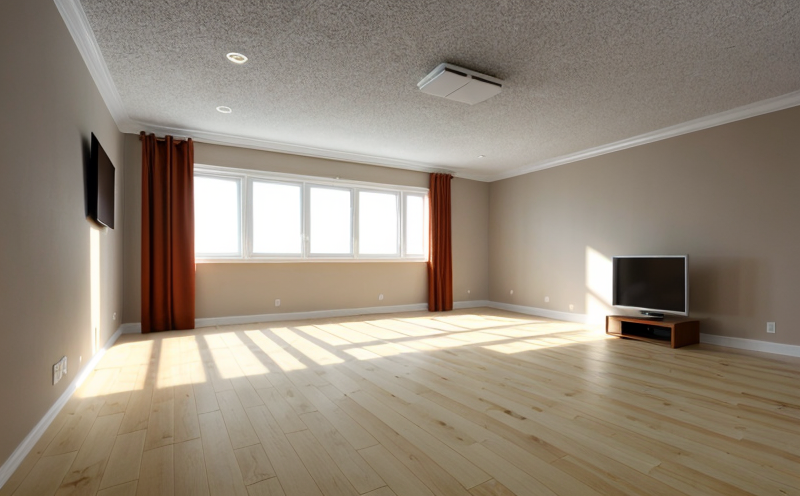ASTM E2235 Measurement of Reverberation Time in Rooms
The ASTM E2235 standard provides a comprehensive approach to measuring reverberation time (Tr) in rooms, which is critical for ensuring the acoustic performance and comfort within various environments. This test method is widely applicable in sectors such as architecture, construction, and building design where sound quality and room acoustics are paramount.
The measurement of reverberation time helps to determine how sound decays over time inside a space. A longer reverberation time can result in an echoey or boomy environment, which is often undesirable for certain applications such as concert halls, recording studios, and offices. Conversely, too short a reverberation time may lead to a dead-sounding room, which can be equally problematic.
The ASTM E2235 test method involves the use of specialized equipment including sound level meters and microphones placed at specific distances from the source. The procedure requires careful preparation of the testing environment to ensure that extraneous noise does not interfere with accurate measurements. Compliance with this standard ensures consistency in test results, which is essential for quality control and regulatory compliance.
The reverberation time measured using ASTM E2235 can influence design decisions related to insulation materials, sound absorption treatments, and the overall layout of a space. For instance, it informs the selection of appropriate ceiling tiles or wall panels that help achieve desired acoustic properties. Additionally, this test method supports the development of standards for new building codes and guidelines for existing facilities.
In terms of specimen preparation, the room being tested should be free from any sound-absorbing materials until testing begins to ensure accurate measurements. After obtaining the reverberation time data, it is essential to compare these results against established benchmarks or design specifications to determine if further adjustments are needed.
- Industry Applications: The ASTM E2235 test method finds application in various sectors including architecture, construction, and building design. It plays a crucial role in ensuring that newly constructed buildings meet the required acoustic standards set by international organizations like ISO or local authorities.
- Environmental and Sustainability Contributions: By promoting better understanding of room acoustics through accurate measurements, ASTM E2235 indirectly contributes to sustainable development goals by encouraging more thoughtful use of resources. Properly designed spaces can lead to reduced energy consumption due to optimized heating, ventilation, and air conditioning systems.
Industry Applications
- Architecture: Ensures that newly constructed buildings meet the required acoustic standards set by international organizations like ISO or local authorities.
- Construction: Provides a method for verifying the effectiveness of sound insulation materials before final construction is completed.
- Building Design: Supports the development of new building codes and guidelines for existing facilities, ensuring that all spaces are designed with user experience in mind.
- Recording Studios: Helps maintain high-quality audio recordings by minimizing echo and reverberation that could distort sound.
- Hospital Rooms: Ensures that patients can have restful sleep or recover comfortably without being disturbed by excessive noise levels.
Why Choose This Test
The ASTM E2235 measurement of reverberation time offers several advantages over other methods. Its precision and accuracy make it ideal for compliance with international standards, ensuring consistent results across different testing environments. The test method allows for detailed analysis of room acoustics, providing valuable insights into how sound behaves within a space.
One key benefit is the ability to identify areas where improvements can be made in terms of sound insulation and absorption. This information is crucial for architects and engineers during the design phase, helping them make informed decisions about materials and configurations that will enhance the acoustic performance of a building. Additionally, ASTM E2235 supports ongoing maintenance efforts by identifying any changes in room acoustics over time.
Another advantage lies in its contribution to sustainable development goals. By promoting better understanding of room acoustics through accurate measurements, ASTM E2235 indirectly contributes to resource efficiency by encouraging more thoughtful use of materials and energy resources. Properly designed spaces can lead to reduced energy consumption due to optimized heating, ventilation, and air conditioning systems.
Furthermore, the test method facilitates compliance with regulations imposed by various governmental bodies around the world. This ensures that all stakeholders involved in construction projects are aware of their responsibilities regarding acoustic performance, thereby fostering a culture of accountability and quality assurance.
Environmental and Sustainability Contributions
- Promotes better understanding of room acoustics through accurate measurements.
- Informs decisions about materials and configurations that enhance the acoustic performance of a building.
- Supports ongoing maintenance efforts by identifying changes in room acoustics over time.
- Fosters a culture of accountability and quality assurance among all stakeholders involved in construction projects.





